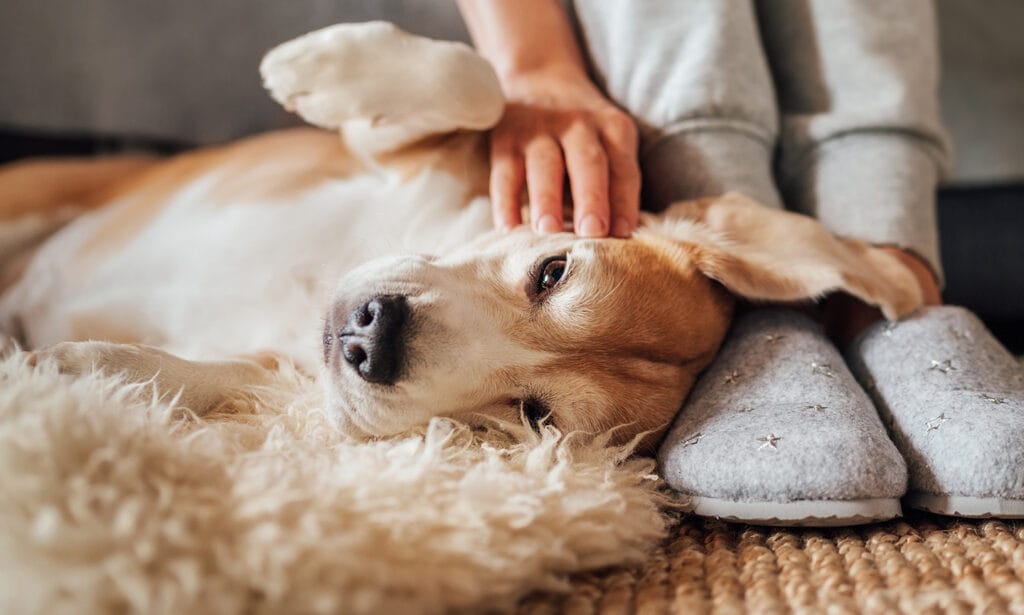There’s no denying it: Fleas are pests in every sense of the word! They’re itchy, gross, and—perhaps worst of all—prolific if not dealt with properly. One of the best ways to prevent this pest from infiltrating your home and causing your pet distress is to know the most common signs of fleas in dogs.
And here's the thing: Even if you don’t see any fleas or flea symptoms in dogs, don’t assume there are none in your home. Fleas go through four stages in their life cycle—egg, larva, pupa and adult. Even if you see no adult fleas on your dog’s body, there still could be fleas in the three other developmental life stages in your furniture, carpet, or baseboards that are just days or weeks away from turning into adults and invading your dog. That’s why it’s important to always be tuned in to the signs of flea infestation. Today, your dog may be flea-free. Tomorrow, they might not be.
Common Signs of Fleas in Dogs
1Intense and Frantic Scratching or Biting
Flea bites can cause your dog’s skin to feel very itchy, which can be downright miserable for your pup. One of the symptoms of fleas on dogs is if your dog suddenly starts scratching their body with their paws or chewing their skin in an attempt to find some relief. They may even keep you up at night with ceaseless scratching and chewing.
To help give them temporary relief, use dog flea and tick shampoo, like Veterinary Formula Clinical Care’s flea and tick shampoo, or an after-bath treatment like TropiClean Natural Flea & Tick Bite Relief Dog Spray.
2Excessive Grooming and Hair Loss
3Agitation, Edginess and Restlessness
4Hot Spots
5Muscle Loss, Pale Gums or Lethargy
6Tiny, Pepper-Like Specks on Their Fur
7Dark Spots in Their Bedding Fabric
8Tiny Reddish-Brown Insects on Their Fur
So, what do fleas on dogs look like? Sort of what you’d expect: Tiny reddish-brown insects. They’re tiny, but still big enough to see with the naked eye.
If there’s a heavy infestation, there’s a good chance you’ll see the fleas easily. In some cases, you may even be able to see the actual flea eggs, though these are a bit harder to make out. Fleas tend to gravitate to the rump and tail area of dogs, so check here first.
9‘Rice Grains’ on Their Bedding or Around Their Anus/Feces
If you see what looks like rice grains on your dog’s bedding, around their anus, or even squirming around in their feces, there is a good chance that your dog has tapeworms. The rice grains are the egg packets that tapeworms release.
Tapeworms require fleas as part of their life cycle. While some dogs can develop tapeworms after eating infected prey animals, most dogs develop tapeworms from accidentally ingesting an infected flea while grooming. If you see tapeworms, there’s a good chance your dog also has fleas.
FAQs About Fleas on Dogs
Q:
Are fleas in dogs visible to the human eye?
Q:
What is the difference between signs of fleas and ticks in dogs?
A:Signs of fleas can include itching, scratching, hair loss, and red and raw hot spots around the lower back or base of the tail. You may also notice flea dirt (technically flea poop) and see the actual fleas themselves. Adult fleas have six legs and jump long distances.
Conversely, a tick usually feels like a small, stationary bump where the tick has attached itself to the dog. A tick has eight legs and may move more slowly compared to a flea.
Q:
Where on the dog's body can you spot fleas?
A:Fleas like to hide on the neck, lower back, hind legs and tail.
Fleas are a risk you take when you have a dog. If you’ve noticed any of the signs above, the bad news is that there’s a good chance your dog has a flea infestation. But the good news is that with treatment and home cleaning, you can eradicate flea problems on your dog and in your home.
More about fleas:
Share:











